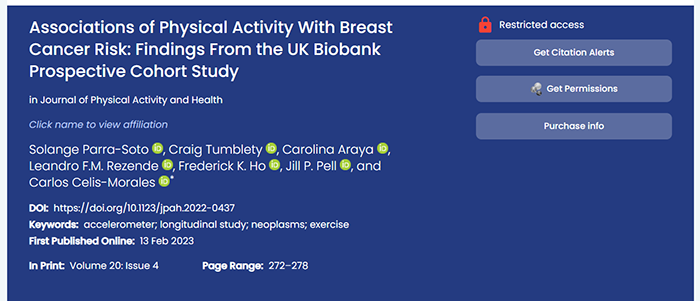Carlos Celis-Morales involved in New Paper
Published: 25 May 2023
Associations of Physical Activity With Breast Cancer Risk: Findings From the UK Biobank Prospective Cohort Study
Associations of Physical Activity With Breast Cancer Risk: Findings From the UK Biobank Prospective Cohort Study
, , , , , , and Carlos Celis-Morales

Abstract
Purpose: Although physical activity (PA) has been consistently associated with breast cancer, existing evidence is limited to self-reported physical activity, which is prone to dilution bias. Therefore, this aims to examine the associations of device-measured PA domains with breast cancer risk and whether it differs by menopausal status. Methods: Prospective cohort study. Data from 48,286 women from the UK Biobank cohort were analyzed. A wrist triaxial accelerometer was used to collect physical activity data for light, moderate, vigorous, moderate to vigorous, and total PA. Cox proportional models were performed to examine the association between PA domains, menopausal status, and breast cancer risk. Results: Eight hundred thirty-six breast cancer cases were diagnosed during a median of 5.4 years (interquartile range: 4.7–5.9). For total PA, those in the most active quartile had a 26% lower risk of breast cancer (Hazard ratio [HR]: 0.74; 95% confidence interval [CI], 0.61–0.91) compared with those least active. Similar results were observed for light PA (HR: 0.79; 95% CI, 0.64–0.96), and moderate to vigorous PA (HR: 0.78; 95% CI, 0.64–0.96). However, moderate PA (HR: 0.73; 95% CI, 0.44–1.19) and vigorous PA (HR: 0.77; 95% CI, 0.56–1.05) was nonsignificant. No evidence of interaction between PA domains and menopause status was found (P > .10). Conclusion: High levels of PA are associated with a lower risk of breast cancer with similar magnitude of associations observed across different intensity domains.
First published: 25 May 2023

